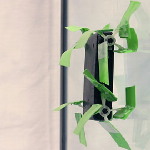Flies and Whegs: Sticky Feet Robotics
 Biomimetics is off and looking at practically anything for inspiration. Insects are a particular favorite, of course, particularly those that fly, climb, and perform other gravity-defying tricks.
Biomimetics is off and looking at practically anything for inspiration. Insects are a particular favorite, of course, particularly those that fly, climb, and perform other gravity-defying tricks.Take the fly, for instance. How does it walk upside down? German researchers recently proved that flies rely on “a glue-like substance made of sugars and oils.” The insects zoom and slick themselves up there, then peeling off their feet as they walk.
The Biologically Inspired Robotics Lab at Case Western Reserve University, upon reading the report and collaborating with the Germans, promptly mimicked the sticky climbing feat. The robot? A Wheg, of course.
